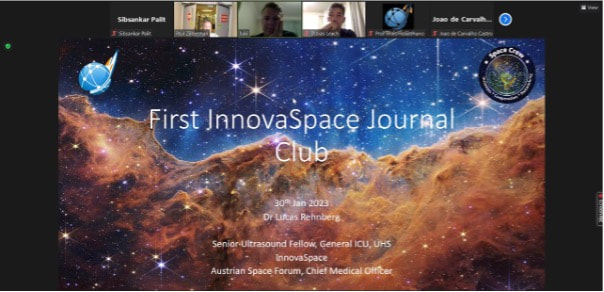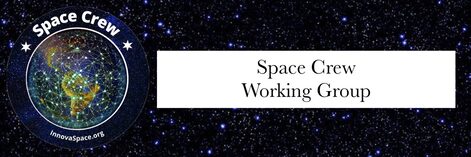InnovaSpace Journal Club #1 Report: Jugular Venous Blood Flow Stasis & Thrombosis During Spaceflight4/2/2023
Author: Lucas RehnbergNHS Doctor - Anaesthetics & Intensive Care | MSc Space Physiology & Health Extremely pleased to report on the 1st InnovaSpace Journal Club meeting that had the participation of a very international audience, with attendees from Belgium, Brazil, India, Israel, Italy, Romania, and UK! Thank you to all those who attended and look forward to future talks and discussions. For those who couldn’t attend, or are interested in the Space Journal Club, I have created a ‘one page’ summary of the paper we discussed. I have also added in the discussion points raised after the critical appraisal of the paper, together with links to additional reading material for anyone wishing to learn more. PAPER PRESENTED & DISCUSSED: HEADLINE: After 50+ years of spaceflight, the first documented venous thrombus in an astronaut identified - highlighting a new pathology, not previously diagnosed in astronauts. Who are the authors? Experts in this field from several space agencies => NASA, IBMP (Russia), ESA Funding => NASA, under the Human research program. Part of the multi-institution international fluid shifts study. What is interesting about this paper/ Why would the medical space community be interested in this? New pathology, not diagnosed before. Potentially massive implications for future long duration missions. LBNP could potentially be a countermeasure to enhance venous blood flow or improve cerebral venous outflow. The research question. Loss of hydrostatic gradient and variation on Earth, sustained fluid redistribution. Effect on cerebral venous drainage/blood flow. Possible mechanism linked to SANS? Increased risk of clot formation due to static/retrograde flow? Aims:
Why is this research question important? Static/stagnant flow can predispose individuals to thrombus formation. Long lasting effects of thrombi for astronauts, potentially affecting crew performance (i.e. risk of anticoagulation, emboli, then leading to reduced performance affecting the crew and mission). The study design. Primary research => prospective cohort study (follow a similar patient group over time, comparing a particular outcome). Subjects were 11 astronauts, on the ISS. Method: Ultrasonographic assessment of left IJV (IJV are main conduits of cerebral drainage) - pre flight (3 positions, seated, supine & head down tilt) - at approximately D50 and D150 of spaceflight - with and without LBNP (approx the same days, Russian Chibis-M LBNP)
<
>
9 crew members participated in LBNP sessions. 17 LBNP sessions, 10 of these (59%) showed improved IJV blood flow patterns. Other 7 sessions were equal or worse flow. No syncopal episodes recorded. Potential countermeasure to blood flow stasis and thrombosis (but DIDN’T reach seated baseline in +1Gz). Flaws? Biases? Limitations? All papers that involve human subjects in space have a common flaw => lack of numbers (compared to terrestrial studies) Non-invasive pressure measuring of IJV likely overestimated values. Only the left IJV was assessed (right IJV has been examined previously). No lower limb assessment either (i.e. for DVTs). Measurements over 150 days, LOTS of variables (exercise, EVAs, other activities, diet, etc). Can these results be applied to your patient population? (i.e. other astronauts) In my opinion => YES! Tough with small sample size to draw definitive conclusions. However, it would almost be irresponsible to ignore and say it is a ‘one off’. Tested in similar population in similar conditions (i.e. not in a lab or analogue in simulated conditions like 6o head down). Space medicine is often ‘best evidence we have’ based, augmented with experts and experience. Is this clinically relevant and how could this affect future management and treatment? There needs to be a lot more research to determine the actual level of risk of thrombus formation in microgravity, affects of countermeasures on venous blood flow, and benefits of screening pre and during flight. Then future management -crews performing point of care ultrasound with minimal support (with time delays going to Mars), limited resources and pharmacy, prophylaxis, risk/benefit of anticoagulation, and so many more questions! DISCUSSIONDiscussion of the paper after the critical appraisal was very interesting with a variety of topics and issues raised, such as:
Additional reading Surveillance for jugular venous thrombosis in astronauts. Pavela et al 2022 https://journals.sagepub.com/doi/full/10.1177/1358863X221086619 The Vascular Frontier: Exploring the diagnosis and management of vascular conditions in spaceflight. Drudi et al 2022 https://journals.sagepub.com/stoken/default+domain/RI2YQPUZTFUKTETSURTI/full?utm_campaign=vmj_may2022&utm_content=articlepromo&utm_medium=referral&utm_source=sagepub.com Venous Thrombosis during Spaceflight. Auñón-Chancello et al 2020 https://www.nejm.org/doi/full/10.1056/NEJMc1905875 The effect of microgravity on the human venous system and blood coagulation: a systematic review. Kim et al 2021 https://physoc.onlinelibrary.wiley.com/doi/full/10.1113/EP089409 Missed the discussion? Catch up below with InnovaSpace YouTube videos! Sign up to our social media (@InnovaSpaceNews) for future Journal Club dates. Comments are closed.
|
Welcometo the InnovaSpace Knowledge Station Categories
All
|
InnovaSpace Ltd - Registered in England & Wales - No. 11323249
UK Office: 88 Tideslea Path, London, SE280LZ
Privacy Policy I Terms & Conditions
© 2024 InnovaSpace, All Rights Reserved
UK Office: 88 Tideslea Path, London, SE280LZ
Privacy Policy I Terms & Conditions
© 2024 InnovaSpace, All Rights Reserved





 RSS Feed
RSS Feed